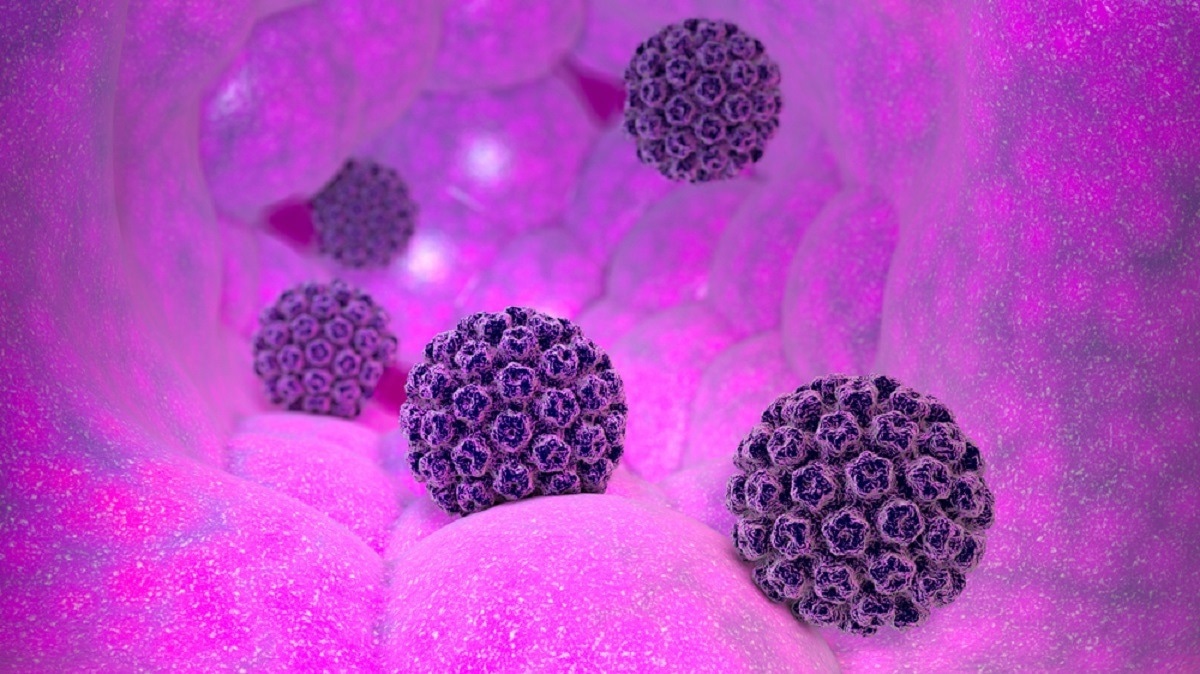Human Papillomavirus (HPV) causes cervical cancer and genital warts, a common sexually transmitted infection. Even after the implementation of prophylactic HPV vaccination in young women, cervical cancer remains the fourth most common type of cancer globally.

Background
In most cases, HPV infection clears spontaneously within 6-18 months. This might be due to the genital microbiome, host defense mechanisms, and other factors associated with the female genital tract. Recently, researchers have reviewed the role of cytokine or cellular response and vaginal microbiome dysbiosis in the persistence, clearance, and recurrence of HPV infection. This study is available in Frontiers in Cellular and Infection Microbiology.
HPV diagnosis, treatment, and preventive strategies
Scientists have characterized HPV as a non-enveloped, double-stranded DNA virus that belongs to the family papillomaviridae. This virus infects the squamous epithelium, which is present under the foreskin of the vulva, cervix, vagina, anus, scrotum, and penis. Among the different types of HPV, the Alphapapillomavirus genus mostly affects the genital tracts of humans.
Researchers have characterized more than 200 genital HPV genotypes. Certain types of HPV cause low-risk diseases, while others cause high-risk ones, such as cervical cancer and Cervical intra-epithelial neoplasia (CIN). Some of the high-risk HPV types are HPV 16, 18, 31, 33, 35, 39, 45, 51, 52, 56, 68, and 59. However, HPV 16 and 18 are responsible for 70% of cervical cancer cases. Among the low-risk HPV types, the most commonly occurring are HPV 6 and 11, which cause 90% of genital warts.
Some of the common tools and techniques used to detect HPV are nucleic acid-based tests, Pap smear tests, colposcopy, biopsy, and acetic acid tests. However, a Pap smear is the main screening tool used to detect precancerous cells in the cervix.
Even though no effective treatment is available for HPV infection, vaccination has been used to prevent it. Commercially, three types of vaccines, i.e., bivalent, quadrivalent and nonavalent, are available against HPV infection. However, these vaccines cannot protect against all types of HPV viruses. Women diagnosed with precancerous lesions due to HPV infection are provided with different types of treatment, including surgery and radiotherapy.
Immune responses and HPV infection
Scientists have reported that innate and adaptive immunity protects hosts at the mucosal surface from HPV virus invasion. After HPV infection, the immune system gets activated, where mature antigen-presenting cells (APCs) secrete cytokine, which in turn, induces activation and deployment of other immune cells in the infection site.
Previous studies have highlighted the relationship between genital mucosal cytokine levels and management, i.e., control and clearance, of HPV infection in the cervix. Scientists have reported that within a few days of HPV infection, cytokine concentration in the cervix increases, subsequently reducing the following clearance of HPV from the cervix. Mechanistically, when mature APC interacts with naïve CD4+ and CD8+ T cells, it differentiates into varied T helper effector lineages and cytotoxic T lymphocytes (CTLs), respectively. These cells clear the virus from the host.
Prior studies have shown that the host’s immune system cannot always prevent disease progression. This is because HPV deploys various mechanisms to evade host immune responses, including modification of APC function and inhibition of keratinocyte CCL20 expression that might compromise the cytotoxic immune response.
Researchers reported that HPV evades natural killer cells, an important component of the innate immune response. They also detected high levels of the anti-inflammatory cytokine, i.e., IL-10, in women with persistent HPV infection, compared to those who cleared the HPV infection. Studies have also shown that HPV infection can alter the differentiation of monocytes into mature dendritic cells and affects the function of CD4+/CD8+ and regulatory T cells.
Vaginal microbiome and HPV infection
The authors found substantial evidence suggesting that women with a relatively low abundance of vaginal Lactobacillus species and high concentration of microbes belonging to genera Sneathia, Atopobium, and Gardnerella, were at a higher risk of not clearing HPV infection.
Interestingly, several microscopic and molecular-based studies have indicated that women with a relatively higher concentration of Lactobacillus in their vaginal microbiome are less likely to contract HPB infection. In contrast, women with a higher level of bacterial vaginosis (BV)-linked bacteria, such as Dialister, Atopobium, Streptococcus, Prevotella, Megasphaera, Mycoplasma, and Gardnerella, are highly likely to acquire HPV infection.
Scientists have reported that Lactobacillus gasseri-enriched microbiome has significantly enhanced the HPV clearance rate. However, women with CIN showed a high abundance of L. iners in their vaginal microbiome. Studies have also shown that certain vaginal microbiota can modulate hosts' immune responses, i.e., altering important anti-tumor and anti-viral immunity components in the female genital tract.
Conclusion
The authors stated that although several studies indicated the relationship between host immune response, vaginal microbiome, and HPV infection, the factor behind the advancement of HPV-associated cervical cancer is not well understood. Hence, it is imperative to understand the role of vaginal microbiome fluctuations and host immune responses at different stages of HPV infection. It will help researchers understand the mechanisms behind cervical carcinogenesis.
- Ntuli, L. et al. (2022) "Role of Immunity and Vaginal Microbiome in Clearance and Persistence of Human Papillomavirus Infection", Frontiers in Cellular and Infection Microbiology, 12. doi: 10.3389/fcimb.2022.927131. https://www.frontiersin.org/articles/10.3389/fcimb.2022.927131/full
Posted in: Medical Science News | Medical Research News | Disease/Infection News
Tags: Antigen, Anti-Inflammatory, Bacteria, Bacterial Vaginosis, Biopsy, Cancer, Carcinogenesis, CCL20, CD4, Cervical Cancer, Cervix, Colposcopy, Cytokine, DNA, Dysbiosis, Immune Response, Immune System, immunity, Lactobacillus, Microbiology, Microbiome, Mycoplasma, Natural Killer Cells, neoplasia, Nucleic Acid, Pap Smear, Penis, Radiotherapy, Surgery, Tumor, Vagina, Vaginal, Vaginal Microbiome, Virus, Vulva

Written by
Dr. Priyom Bose
Priyom holds a Ph.D. in Plant Biology and Biotechnology from the University of Madras, India. She is an active researcher and an experienced science writer. Priyom has also co-authored several original research articles that have been published in reputed peer-reviewed journals. She is also an avid reader and an amateur photographer.
Source: Read Full Article